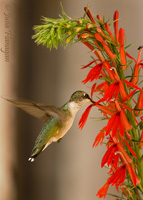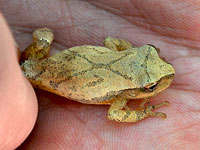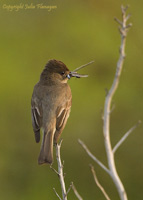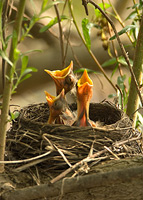The Merrimac Farm Conservation Landscape will transform the back yard of the Merrimac Farm Stone House into a diverse habitat for birds, butterflies, turtles, amphibians and more. Here creatures great and small will find nesting sites, food and places to rest and hide among a wealth of Virginia's native plants.
Through this demonstration project, we're showing how everyone can do their part to protect a little nature while Northern Virginia continues to grow.
 Habitat Area A – Avian Garden. Habitat Area A – Avian Garden.
This habitat will occupy the southern portion of the back yard closest to the farm house. Currently the only vegetation is a non-native lawn interrupted only by a single black walnut.
The area will be transformed into an alcove of bird friendly trees and shrubs, giving birds a reason to come in close to the house for observation and enjoyment. An evergreen screen of American holly set farther from the house will form a backdrop to flowering dogwood and berry producing shrubs like silky dogwood and shadblow serviceberry, and cover plants like catawba rhododendron.
Perennials such as cardinal flower, trumpet honeysuckle and wild columbine will supply hummingbirds the nectar they need. A small redbud tree will provide a shady break by benches set out to view to the west and north into the Transitional Forest, Butterfly and Upland Meadow.
Habitat Area B – Especially for Butterflies
Located immediately to the right as you walk out the back steps, the future home of the Butterfly Habitat is a veritable desert of lawn. But not for long. This design will take advantage of this sunny nook to establish a large variety of perennials like black-eyed susans, purple coneflowers, coreopsis, goldenrod, blazing star, milkweeds, great blue lobelia and wild bergamot, just to name a few.
Plants will be chosen for both their nectar producing capabilities and their ability to host butterfly and moth larvae. Trellises with climbing natives, such as passionvine, will bring a vertical component to soften the back walls of the house.
 Habitat Area P – Wetland Pool Habitat Area P – Wetland Pool
Situated between the Avian and Butterfly Habitats, a small pool was filled in and grassed over a few years ago so that it is completely non-functional. However, all wildlife needs water, so this small water feature will be restored and redesigned.
Varying water depths, rocks, emergent herbaceous plant like lizards tail, and a moist sand area will demonstrate how simple it is to provide the wetland habitat butterflies, frogs, salamanders and turtles need right in your backyard. Installation of a such a small pond can reward you with calling frogs within 48 hours of its completion!
 Habitat Area C – Allée and Walking Path Habitat Area C – Allée and Walking Path
Leading north from The Pool and Butterfly Habitats, a walking path will guide you through an allée of serviceberry trees to the Native Meadow situated in the northern end of the large abandoned field behind the house.
Habitat Area D –Upland Meadow
Most fields and meadows in our area are like this, full of non-native grasses and forbs like fescue, crabgrass, Japanese honeysuckle and garlic mustard. A carefully timed process of mowing, herbiciding, tilling, and seeding will be the ground work (literally!) for transforming this expanse into a meadow rejuvenated with species such as little bluestem, Virginia wild rye, purple lovegrass, and partridge pea.
These and other natives will supply seasonal food for songbirds that eat seed or catch insects on the wing such as Eastern wood-pewee, Eastern phoebe, and Acadian flycatchers, and small mammals like the white-footed mouse. Hawks and owls may forage in this field.
 Habitat Area F –Transitional Forest Edge Habitat Area F –Transitional Forest Edge
Over time, meadows naturally give way to forests in the process of succession. As you move south into the mid-section of the abandoned field you will enter the area currently planned for Transitional Forest habitat.
At this time, this area is giving way to an invasion of non-native woody plants like autumn olive and Bradford pear. These exotic pest plants can overwhelm the native trees and shrubs that are typically found in transitional forests.
This proposal replaces the non-natives with beautiful, fruitful shrubs like smooth and winged sumac, mountain ash, and black-haw viburnum. Trees like persimmon and sassafras will be added to complement the early successional trees species already present around the edge: red cedar, black cherry and black walnut.
 Habitat Area G – Moist Meadow Habitat Area G – Moist Meadow
Last but not least is the southernmost end of the abandoned field. Lowest in elevation, this shady nook receives water draining from the higher ground to the north making it moist to wet throughout much of the year.
Unfortunately, alien plants like multi-flora rose and autumn olive like it here too. These will be removed and replaced with delightful herbaceous plants like bluebells, swamp milkweed, and New York ironweed; berry producing shrubs like elderberry, winterberry holly and arrowwood viburnum; and trees like river birch and box elder.
This area is a known birding hotspot on the property and these natives will supply berries, seed and nectar to keep it that way. |